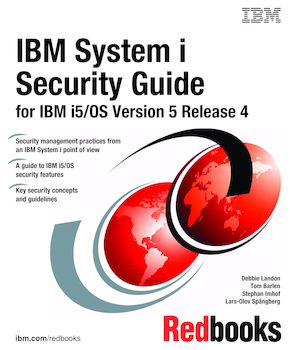IBM System i Security Guide for IBM i5/OS Version 5 Release 4
An IBM Redbooks publication
Note: This is publication is now archived. For reference only.

Published on 11 October 2006, updated 13 December 2007
Note
ISBN-10: 0738496863
ISBN-13: 9780738496863
IBM Form #: SG24-6668-01
Authors: Deb Landon, Debbie Landon, Tom Barlen, Stephan Imhof and Lars-Olov Spångberg
The IBM System i family, with its operating system IBM i5/OS, is considered one of the most secure systems in the industry. From the beginning, security was designed as an integral part of the system. The System i platform provides a rich set of security features and services that pertain to the goals of authentication, authorization, integrity, confidentiality, and auditing. However, if an IBM Client does not know that a service, such as a virtual private network (VPN) or hardware cryptographic support, exists on the system, they will not use it.
In addition, there are more and more security auditors and consultants who are in charge of implementing corporate security policies in an organization. In many cases, they are not familiar with the System i platform, but need to understand the security services that are available.
This IBM Redbooks publication guides you through the native security features that are available on the System i platform. This book is intended for security auditors and consultants, IBM System Specialists, Business Partners, and Clients to help you answer first-level questions concerning the security features that are available on the System i platform.
Part 1. Security concepts
Chapter 1. Security management practices
Chapter 2. Security process and policies
Chapter 3. System i security overview
Part 2. The basics of System i security
Chapter 4. System i security fundamentals
Chapter 5. Security tools
Chapter 6. Security audit journal
Chapter 7. Confidentiality and integrity
Part 3. Network security
Chapter 8. TCP/IP security
Chapter 9. Cryptographic support
Chapter 10. Virtual private network
Chapter 11. Firewalls
Part 4. Authentication
Chapter 12. System i authentication methods
Chapter 13. Single sign-on
Part 5. Security management
Chapter 14. Regulations and standards
Chapter 15. Security monitoring
Chapter 16. Considerations and recommendations
Appendix A. LPAR security considerations
Appendix B. Operations Console
Appendix C. Applications and middleware security considerations
Appendix D. Program temporary fixes